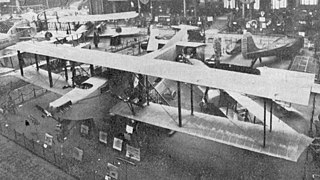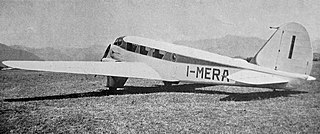
The Aero Letňany A.10 was a biplane airliner produced in Czechoslovakia shortly after World War I. It was the first commercial aircraft to be built in Czechoslovakia and was known as the Ae-10 Limousine. It was designed by Husnik and Vlasak and was intended to meet the growing need for aerial communication to and from the country. Behind the single nose-mounted engine was a cabin with seats for three and two tables, upholstered on the underside, and able to be inverted to provide another two seats if required. A double skinned firewall between the engine and cabin, together with double skinned surfaces to the walls, floor and roof and Triplex windows gave a (relatively) quiet ride. A rear window gave communication with the pilot, whose open cockpit was above and behind the cabin. The cockpit also accommodated the navigator who had a seat directly behind the pilot.
The Aero Boero AB-150 is an Argentine civil utility aircraft, developed in parallel with the AB-180 as a lower-cost, lower-powered version of that aircraft. Like the 180, it was produced by Aero Boero in long-range and agricultural variants.

The Bristol Type 170 Superfreighter Mk 32 was a larger, stretched version of the Bristol Freighter designed for Silver City Airways for use on the short air ferry routes to France.

The Blériot-SPAD S.27 was a small French airliner developed soon after World War I. It was produced as a way for the Blériot company to find new markets for its wartime products in the postwar market, in this instance by adapting the design of the S.20 fighter into a small airliner. Accommodation for two passengers was provided in a small cabin within the fuselage, but in other respects the S.27 strongly resembled its predecessor.

The Bréguet 26T was a French single-engine biplane airliner that first flew in 1926.

Potez 62 was a French twin-engine civil airliner, designed by Henry Potez in 1934.

The Caudron C.61 was a French three-engined civil transport biplane aircraft built by the French aeroplane manufacturer Caudron. It was constructed of wood and covered in fabric.

The Fiat G.12 was an Italian transport aircraft of World War II.

The Caproni Ca.308 Borea was a small airliner built in Italy in the mid-1930s.

The Dornier Komet ("Comet"), Merkur ("Mercury"), Do C, Do D, and Do T were a family of aircraft manufactured in Germany during the 1920s, originally as small airliners, but which saw military use as well. The earliest aircraft in the series were basically landplane versions of the Delphin flying boat, and although the Delphin and Komet/Merkur series diverged from each other, design changes and refinements from one family were often incorporated into the other. All variants were braced high-winged single-engine monoplanes with conventional landing gear.

The Focke-Wulf A 17 Möwe was an airliner built in Germany in the late 1920s. It was a conventional high-wing cantilever monoplane with fixed tailwheel undercarriage. The aircraft provided fully enclosed seating for up to eight passengers and had a separate, fully enclosed flight deck for the two pilots. Most examples flew with Deutsche Luft Hansa, serving until around 1936. In the early 1930s, two A 17s were used for testing the Junkers Jumo 5 diesel engine.

The Wibault 280-T was a French 12-passenger civil airliner produced by Wibault backed by money from the Penhoët shipyards and also known as 'Penhoët Wibault'.

The Fokker F.XIV was a cargo plane built in the Netherlands in the late 1920s by Fokker. It was a high-wing cantilever monoplane of conventional trimotor layout. The sole example was tested by KLM but never put into service.

The Douglas DF was a commercial flying boat built by Douglas Aircraft Company, first flown on 24 September 1936.

The Lioré et Olivier LeO H-47 was a flying boat airliner built in France in 1936. It was designed to operate passenger services over the South Atlantic, but the outbreak of the Second World War caused the type to be used by the French Navy as a maritime patrol aircraft.

The Potez 56 was a 1930s French executive transport monoplane built by Potez and later used as a military crew trainer and liaison aircraft.

The Sud-Ouest Corse was a French mail and passenger transport aircraft, built by SNCASO.

The Aero-Kros MP-02 Czajka is a Polish ultralight aircraft designed and developed by Aero-Kros of Krosno, introduced at the Aero show held in Friedrichshafen in 2009. The aircraft is supplied ready-to-fly.

The Turbay T-3A was an Argentine twin-engined seven-seater light transport of the 1960s. A single example was built, but no production followed.

The Skyleader GP One is a Czech ultralight aircraft, designed and produced by Skyleader Aircraft and introduced at the AERO Friedrichshafen show in 2010. The aircraft is supplied as a complete ready-to-fly-aircraft.


















